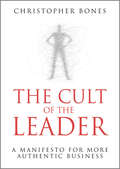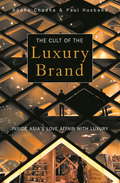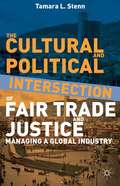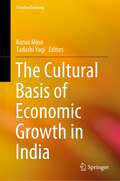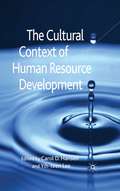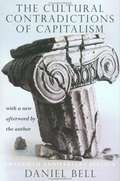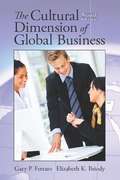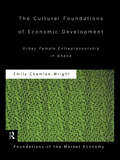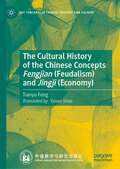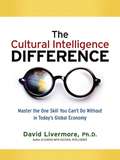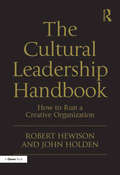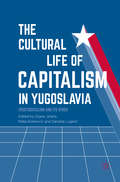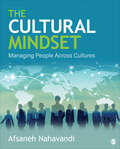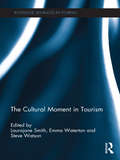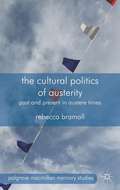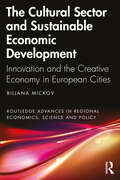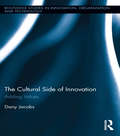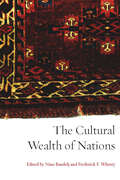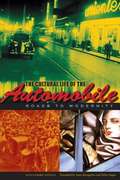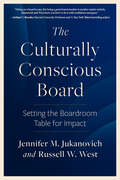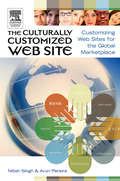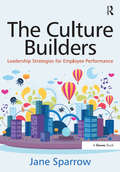- Table View
- List View
The Cult of the Leader
by Christopher BonesA critical look at the way that business leadership has gone so badly wrong.Modern business is obsessed with leaders. We talk about leadership all the time, but its real meaning is becoming more and more obscure. Recent corporate crises have shown that all too often, our leaders are missing in action when we need them most. In this groundbreaking and provocative new book, Chris Bones shows how we need to:Restore trust and confidenceBe more realistic about what leaders can and can't doRedefine talentRevalue experienceReconsider remuneration
The Cult of the Luxury Brand: Inside Asia's Love Affair with Luxury
by Paul Husband Radha ChadhaThe Cult of the Luxury Brand is the first book to explore how and why an amazing "luxeplosion" is rocking Asia, sweeping up not just the glitzy upper crust, but secretaries toting their Burberry bags, junior executives sporting Rolex watches, and university students in Ferragamo shoes. Hong Kong boasts more Gucci and Hermes stores than New York or Paris. China's luxury market is growing with such gusto that it will single-handedly be the biggest by 2014. Even India, the new kid on the luxury block, has three-month waiting lists for hot items, while in Tokyo, the epicenter of the cult, 94 per cent of women in their 20s own a Louis Vuitton bag. The cult of the luxury brand is so powerful that Asian consumers account for as much as half of the $80 billion global luxe industry. Radha Chadha and Paul Husband explain the paradox of simultaneously pumping up your product's status while pumping it out to the masses. They crack the code of the cult, offering a tried-and-tested approach to creating an explosive following for your brand. They outline a powerful model that explains the spread of luxury in developed markets such as Japan and Hong Kong, while predicting the future course for emerging markets such as China and India. They also examine the phenomenon of "geniune fakes", impossible to tell from the real thing but detracting from its sales.Written by world-leading experts in a highly accessible style, the book draws on over 150 interviews with industry experts, market studies in 10 countries, and the authors' collective experience across Asia. It offers a glimpse of the thriving retail scene, from glorious flagship stores in Tokyo to bustling local markets in Seoul, and compares the various consumer segments to understand the inner motives for their obsession. It demonstrates how the continent's massive economic and social transformation is dismantling centuries-old ways of defining your place in society, and how your spot on today's social totem pole is marked by your Chanel suit and your Cartier watch. Whether you are a business professional targeting the Asian consumer, a marketer interested in trend spotting, or a shopper fascinated by luxury brands, this book opens the door to success.
The Cultural And Political Intersection Of Fair Trade And Justice
by Tamara L. StennThe Cultural and Political Intersection of Fair Trade and Justice is an ethnographic study of the effects of Fair Trade on indigenous women, as reported by the women themselves, and seeks to develop a deeper understanding of Fair Trade, globalization, culture, and policy in building justice.
The Cultural Basis of Economic Growth in India (Creative Economy)
by Kazuo Mino Tadashi YagiBased on a three-year joint research project, this book collects studies on the cultural basis of economic growth in India. Unlike the foregoing investigations on India’s economic growth from the economic perspectives, this book presents interdisciplinary discussions on India’s economic growth. The participants in this project consist of a cultural anthropologist who is an expert in the social and historical study on India as well as a group of researchers specializing in various fields of economics such as growth theory, public finance, income distribution, family economics, and economics of education. Our joint research yields new insights on India’s economic growth and social change. In addition, this book presents new findings of happiness in India obtained by our large-scale survey.
The Cultural Context of Human Resource Development
by Carol D. Hansen Yih-Teen LeeAn insight into the understanding of human resource development (HRD) in various cultural contexts. This book looks at how culture shapes our expectations for what is appropriate in the workplace and aims to broaden the reader's knowledge of HRD by exploring the boundaries of existing theories.
The Cultural Contradictions of Capitalism (20th Anniversary Edition)
by Daniel BellThis classic analysis of Western liberal capitalist society contends that capitalism and the culture it creates harbors the seeds of its own downfall by creating a need among successful people for personal gratification a need that corrodes the work ethic that led to their success in the first place.
The Cultural Dimension of Global Business 7th Edition
by Gary P. Ferraro Elizabeth K. BriodyThe Cultural Dimension of Global Business provides a foundation for understanding the impact of culture on global business and global business on culture.
The Cultural Foundations of Economic Development: Urban Female Entrepreneurship in Ghana (Routledge Foundations of the Market Economy)
by Emily Chamlee-WrightChalmlee-Wright argues that international aid programmes have often been unsuccessful because they are imported. The economics of the Austrian School provide a far stronger theoretical framework which can introduce cultural analysis into questions of economic development and other market processes.
The Cultural History of the Chinese Concepts Fengjian (Key Concepts in Chinese Thought and Culture)
by Tianyu FengThis book interprets the typical Chinese concepts of fengjian (feudalism) and jingji (economy) by reviewing the mistranslation and mismatching of concepts from ancient to modern times and from a Western language to Chinese and exploring Chinese and Western acculturation, which is in line with Mr. Chen Yinque’s theory—”To interpret a Chinese character is to write a history of culture”. In the coordinates of time and space for the transformation of Chinese concepts from ancient to modern times and their translation from Western languages, this book explores the generation and evolution of Chinese concepts; using the semantic window of Chinese characters, the book reviews the historical and cultural connotations of the semantic changes and the history of the long-lasting culture of Chinese characters. This volume moves from reviewing the semantic changes of fengjian and jingji to elaborating concepts of thought; it makes the study of the history of terms and concepts the study of the history of culture and thought; it analyzes words as part of cultural history to welcome the era of cultural and historical research with a focus on words.This book is both scholarly and readable, satisfying both the academic needs of specialized researchers and the cultural curiosity of those with secondary education or above.
The Cultural Intelligence Difference: Master the One Skill You Can't Do Without in Today's Global Economy
by David LivermoreMost people know that some basic cultural sensitivity is important. But few have developed the deep cultural intelligence (CQ) required to really thrive in our multicultural workplaces and globalized world. Now everybody can tap into the power of CQ to enhance their skills and capabilities, from managing multi cultural teams and serving a diverse customer base to negotiating with international suppliers and opening offshore markets. The Cultural Intelligence Differencegives readers: * A scientifically validated instrument for measuring their personal CQ score * Customized strategies for improving interactions with people from diverse cultures * New findings on the bottom-line benefits of cultural intelligence * Examples of major organizations that use CQ to achieve success A high CQ points to more than just cultural sensitivity. It is linked to improved decision making, negotiation, networking, and leadership skills - and provides a crucial advantage in a crowded job market. The Cultural Intelligence Differencedelivers a powerful tool for navigating today's work world with finesse - and success.
The Cultural Leadership Handbook: How to Run a Creative Organization
by Robert Hewison John HoldenLeadership has never been more important to the cultural industries. The arts, together with museums and heritage sites, play a vital part in keeping economies going, and, more importantly, in making life worth living. People in the sector face a constant challenge to find support for their organizations and to promote the value of culture. Leadership and management skills are needed to meet the mission of creative arts and cultural organizations, and to generate the income that underpins success. The problem is, where can you learn these essential skills? The Cultural Leadership Handbook written by Robert Hewison and John Holden, both prime movers in pioneering cultural leadership programmes, defines the specific challenges in the cultural sector and enables arts leaders to move from 'just' administration to becoming cultural entrepreneurs, turning good ideas into good business. This book is intended for anyone with a professional or academic interest anywhere in the cultural sector, anywhere in the world. It will give you the edge, enabling to you to show creative leadership at any level in a cultural organization, regardless of whether your particular interest is the performing arts, museums and art galleries, heritage, publishing, films, broadcasting or new media.
The Cultural Life of Capitalism in Yugoslavia
by Dijana Jelača Maša Kolanović Danijela LugarićThis edited volume explores the cultural life of capitalism during socialist and post-socialist times within the geopolitical context of the former Yugoslavia. Through a variety of cutting edge essays at the intersections of critical cultural studies, material culture, visual culture, neo-Marxist theories and situated critiques of neoliberalism, the volume rethinks the relationship between capitalism and socialism. Rather than treating capitalism and socialism as mutually exclusive systems of political, social and economic order, the volume puts forth the idea that in the context of the former Yugoslavia, they are marked by a mutually intertwined existence not only on the economic level, but also on the level of cultural production and consumption. It argues that culture--although very often treated as secondary in the analyses of either socialism, capitalism or their relationship--has an important role in defining, negotiating, and resisting the social, political and economic values of both systems.
The Cultural Mindset: Managing People Across Cultures
by Afsaneh NahavandiThe phenomenon of global organizations reminds us that cross-cultural management is more prevalent than ever. While it may not be possible to develop in-depth knowledge of all cultures, a person can develop a way of thinking where they integrate culture in all of their deliberations, decisions, and behaviors. Such an approach is transformative and involves adopting a cultural mindset, understanding culture’s power as a frame of reference, and developing a new way of thinking. The book Cross-Cultural Management: The Cultural Mindset is based on Dr. Nahavandi’s years of teaching, researching, and consulting with many businesses on cross-cultural issues. Built around a think-know-do model, the text enables readers to adopt a cultural mindset that will effectively guide their thinking and behavior as future managers. Through case studies and self-assessments, the book allows students to develop a broader view of culture that is beyond learning skills and competencies. Additionally, by focusing on culture in general, the book allows readers to address both national cultural issues, such as how to work in another country or manage a multi-national team, and diversity issues, such as the glass ceiling or discrimination in the workplace. The key underlying theme for both topics is how culture, national or group-related, impacts our perspective – what we value, how we think, how we behave, and how we manage people effectively. Each chapter will include a focus on both informational and transformational learning through: · Cases and examples that will question assumptions and emphasize applicability · Self-assessments to make the concepts personal and relevant, and encourage self-reflection · Examples to help students understand those concepts · Specific exercises and/or reflections to help students apply information to their own personal and professional life
The Cultural Mindset: Managing People Across Cultures
by Afsaneh NahavandiThe phenomenon of global organizations reminds us that cross-cultural management is more prevalent than ever. While it may not be possible to develop in-depth knowledge of all cultures, a person can develop a way of thinking where they integrate culture in all of their deliberations, decisions, and behaviors. Such an approach is transformative and involves adopting a cultural mindset, understanding culture’s power as a frame of reference, and developing a new way of thinking. The book Cross-Cultural Management: The Cultural Mindset is based on Dr. Nahavandi’s years of teaching, researching, and consulting with many businesses on cross-cultural issues. Built around a think-know-do model, the text enables readers to adopt a cultural mindset that will effectively guide their thinking and behavior as future managers. Through case studies and self-assessments, the book allows students to develop a broader view of culture that is beyond learning skills and competencies. Additionally, by focusing on culture in general, the book allows readers to address both national cultural issues, such as how to work in another country or manage a multi-national team, and diversity issues, such as the glass ceiling or discrimination in the workplace. The key underlying theme for both topics is how culture, national or group-related, impacts our perspective – what we value, how we think, how we behave, and how we manage people effectively. Each chapter will include a focus on both informational and transformational learning through: · Cases and examples that will question assumptions and emphasize applicability · Self-assessments to make the concepts personal and relevant, and encourage self-reflection · Examples to help students understand those concepts · Specific exercises and/or reflections to help students apply information to their own personal and professional life
The Cultural Moment in Tourism (Advances in Tourism)
by Emma Waterton Steve Watson Laurajane SmithThis book is a response to the burgeoning interest in cultural tourism and the associated need for a coherently theorized approach for understanding the practices that such an interest creates. Cultural tourism has become an important and popular aspect of contemporary tourism studies, as well as providing a rich seam of upscale product development opportunities in the industry as a whole. Much of the related literature, however, focuses upon describing and categorizing cultural tourism from a supply-side perspective. This has prompted the taxonomizing of cultural tourists on the basis of their level of involvement and interest in cultural tourism products and/or their economic worth as a sought after market segment. There have been few recent attempts at a rigorous re-theorization of the issues beyond conventional representational theories; this book aims to fill that void. This groundbreaking volume provides a theoretical and empirical account of what it means to be a cultural or heritage tourist. It achieves this by exploring the interactions of people with places, spaces, intangible heritage and ways of life, not as linear alignments but as seductive ‘moments’ of encounter, engagement, performance and meaning-making, which are constitutive of cultural experience in its broadest sense. The book further explores encounters in cultural tourism as events that capture and constitute important social relations involving power and authority, self-consciousness and social position, gender and space, history and the present. It also explores the consequences these insights have for our understanding of culture and heritage and its management in the context of tourist activity. In capturing the ‘cultural moment’, this book provides a better understanding of the motivations, on-site activities, meaning constructions and other cultural work done by both tourists and tourist operators. The volume confronts and explores the cultural, political and economical interrelations between culture, heritage and the tourism industry. In so doing, it also investigates how this co-mingling of identity, representation and social life may be better apprehended with the wider shift in critical thought towards notions of affect and performativity. The book is a fundamental and influential contribution to research in this field. It will be of significant value to students, academics and researchers interested in this broad topic area.
The Cultural Politics Of Austerity
by Rebecca BramallThis timely book examines austerity's conflicted meanings, from austerity chic and anti-austerity protest to economic and eco-austerity. Bramall's compelling text explores the presence and persuasiveness of the past, developing a new approach to the historical in contemporary cultural politics.
The Cultural Sector and Sustainable Economic Development: Innovation and the Creative Economy in European Cities (Routledge Advances in Regional Economics, Science and Policy)
by Biljana MickovThe cultural sector plays an important role in sustainable economic development and creates economic activities, opportunities for entrepreneurship and jobs, adding to the attractiveness of cities and contributing to the development of tourism. The Cultural Sector and Sustainable Economic Development: Innovation and the Creative Economy in European Cities offers both a theoretical and practical analysis of the contemporary approach to culture and innovation, with special emphasis on the relationships among culture, innovation and the economy. Sustainable development, itself, balances environmental protection, culture, social progress, the economy and stability today and for the future. The book’s key theme is the role and possibility of culture as a laboratory, with a strong supporting subtext on innovative practice. The text provides an eclectic mix of possibilities that reinforce and underscore the full innovative and complex potentials of culture. It is a cross-disciplinary volume presenting case studies that cover the main theme of cultural ecosystem in a very broad sense, highlighting the relationships that could lead to a sustainable system where economy and culture are the main players. It proposes and maps the European perspective of urban cultural development and suggests that the successes and challenges of European cities under consideration may offer guidance on best practices for urban development in other distant cultural contexts. This book is written in such a way that it can be used as a summary for a cultural professional, a reference text for an academic or for actors in local development and cultural policy at European, national and local levels.
The Cultural Side of Innovation: Adding Values (Routledge Studies in Innovation, Organizations and Technology)
by Dany JacobsIn most discussions about the knowledge-based economy, innovation is associated or even equated with technology, while culture’s influence is ignored. Innovation is however embedded in cultural and social contexts, and neglecting these crucial contexts may impede an innovation’s diffusion—and eventual success. This book places culture at the center of discussions on innovation, beginning with a comprehensive introduction to innovation’s various forms, including the history, sociology, and economics of innovation. Insights from marketing and psychology are integrated into a complexity theory framework, which are then utilized to evaluate case studies of organizations experiencing repeated innovation successes. The sometimes fraught relationship of firms to creativity is discussed, and a new model for to calculating the creativity of an economy is presented.
The Cultural Wealth of Nations
by Nina Bandelj Frederick F. WherrySymbolic resources affect social, cultural, and economic development. The value of being "Made in America" or "Made in Italy," for example, depends not only on the material advantages each place offers but also on the symbolic resources embedded in those places of production. Drawing on case studies that range from the vineyards of South Africa and the textiles of Thailand to the Mundo Maya in Latin America and tourist destinations in Tuscany, this volume examines the various forms that cultural wealth takes, the processes involved in its construction, and the ways it is deployed. Leading scholars from a range of disciplinary backgrounds examine how symbolic resources and cultural understandings help firms and regions develop. Through a thoughtful analysis of current- day cases, as well as historical developments,The Cultural Wealth of Nationsoffers an exciting new alternative to standard economic explanations about the wealth and poverty of nations.
The Cultural and Political Economy of Recovery: Social learning in a post-disaster environment (Routledge Advances in Heterodox Economics #12)
by Emily Chamlee-WrightIn August 2005 the nation watched as Hurricane Katrina pummelled the Gulf Coast. Residents did not just suffer the personal costs of a home that had been severely damaged or destroyed; frequently they also lost their entire neighbourhood and the social systems that under normal circumstances made their lives "work". Katrina raised the questions of whether and how communities could solve the complex social coordination problems catastrophic disaster poses, and what inhibits them from doing so? Professor Chamlee-Wright investigates not only the nature of post-disaster recovery, but the nature of the social order itself – how societies are able to achieve a level of complex social coordination that far exceeds our ability to design. By deploying the tools of both political economy and cultural economy, the book contributes to the bourgeoning literature on the social, political and economic impact of Hurricane Katrina. Through a selection of case studies, the author argues that post-disaster resilience depends crucially upon the discovery that unfolds within commercial and civil society. The book will be of particular interest to postgraduate students and researchers in economics, sociology and anthropology as well as disaster specialists.
The Cultural life of the Automobile: Roads to Modernity
by Guillermo GiucciFrom its invention in Europe at the end of the nineteenth century, the automobile crisscrossed the world, completely took over the cities, and became a feature of daily life. Considered basic to the American lifestyle, the car reflected individualism, pragmatism, comfort, and above all modernity. In Latin America, it served as a symbol of distinction, similar to jewelry or fine clothing. In The Cultural Life of the Automobile, Guillermo Giucci focuses on the automobile as an instrument of social change through its "kinetic modernity" and as an embodiment of the tremendous social impact of technology on cultural life. Material culture-how certain objects generate a wide array of cultural responses-has been the focus of much scholarly discussion in recent years. The automobile wrought major changes and inspired images in language, literature, and popular culture. Focusing primarily on Latin America but also covering the United States, Europe, Asia, and Africa, Giucci examines how the automobile was variously adapted by different cultures and how its use shaped and changed social and economic relationships within them. At the same time, he shows how the "automobilization" of society became an essential support for the development of modern individualism, and the automobile its clearest material manifestation.
The Culturally Conscious Board: Setting the Boardroom Table for Impact
by Jennifer M. Jukanovich Russell W. WestThe definitive introduction for changemakers new to the world of nonprofit and small business boards of directors.Bust the status quo of board room administrative tedium and passive participation to contribute to meaningful social transformation and impact in your organization. Authors Jukanovich and West offer changemakers new to the boardroom the mindset and strategies necessary to make a difference in the organizations they lead.Mission-based, socially responsible, and transformational organizations are needed more today than ever. And the boards that lead them must be in tune with their stakeholder's culture. But so often they are held back by ineffective decision making and a lack of interpersonal trust.This book breaks down the key elements of a successful boardroom and how to achieve them. From onboarding diverse talent to establishing trust through accountability, you will have the tools and actionable techniques needed to effectively make a difference in the world with healthier boardroom practices.
The Culturally Customized Web Site
by Nitish Singh Arun PereiraIn The Culturally Customized Web Site, Nitish Singh and Arun Pereira focus on cultural aspects of international website design, honing in on three objectives:* First, to present a review and survey results on standardization/localization issues on the web* Second, to present a scientifically tested framework to design culturally adapted international websites, and provide marketers and web designers with practical web localization tools* Third, to show readers the power and effectiveness of culturally customized websitesThis is the first book to address the issue of website standardization, localization—or what the authors refer to as “cultural customization”. Little evidence has been accumulated to show whether international consumers prefer to browse and buy from standardized global websites or websites adapted to local cultures. The Culturally Customized Web Site provides insights into whether the web is a culturally neutral medium of communication or a medium impregnated with cultural values. Also presented is empirical evidence as to whether local consumers prefer standardized websites or websites adapted to their culture.Visit www.theculturallycustomizedwebsite.com
The Culture Advantage: Empowering your People to Drive Innovation
by Daniel StrodeInnovation is the key to making your business go the distance. Innovate or die they say. But where does innovation lie? The answer is in your people.Far from being the privilege of the unicorns of Silicon Valley, innovation isn't dependent on business model, structure or even budget. By harnessing your people's power through a corporate culture of innovation, you unlock business opportunities that your competition won't have access to. The Culture Advantage is a blueprint to designing, implementing and sustaining a culture that will not only celebrate innovation, but will imbue it in everything your company, and its people, do.Culture evangelist, Daniel Strode, with the help of some of the world's historically most inspiring and innovative businesses like The Walt Disney Company and The LEGO Group, as well as newer companies like Art Blocks from the Web 3.0 and blockchain space, breaks down the innovation puzzle. Through evaluating your business model; daring to chip away at it; empowering your people through technologies; psychological safety and leadership; putting constraints onto their creative efforts; and hiring and collaborating with the right types of innovators, you'll discover how to enhance your adaptability and futureproof your business.
The Culture Builders: Leadership Strategies for Employee Performance
by Jane SparrowAs with many people-oriented initiatives, employee engagement remains an emerging science with as many advocates as detractors. In The Culture Builders Jane Sparrow shares the insight of her research and experience into how companies are creating an engaged workforce. Along the way she looks at the evidence, the case for engagement and how organizations are measuring and defining it. Having an engagement strategy is merely a first step and so the book explores how to enable the manager-as-engager. Alongside the practical models and the guidance, there are stories and examples from leaders and organizations allowing you to learn, amongst other things, about the strong sense of purpose felt in John Lewis Partnership; the importance Innocence places on values; how Sony has used visual metaphors to give context and strategic direction and how MGM Resorts targets engagement strategies to the needs of specific employee groups. The need for sustained employee performance has been put into sharp focus in recent years. The Culture Builders is a book that provides the theory and practice to connect employee engagement to long-term performance. Simply reading it won’t guarantee that performance. Reading it, learning and applying the lessons it offers, will dramatically improve your chances.
